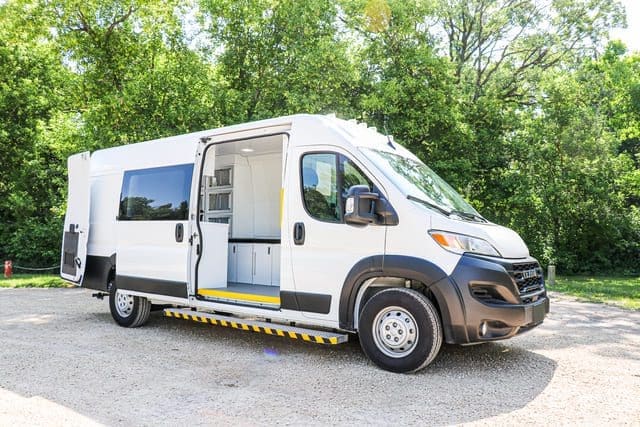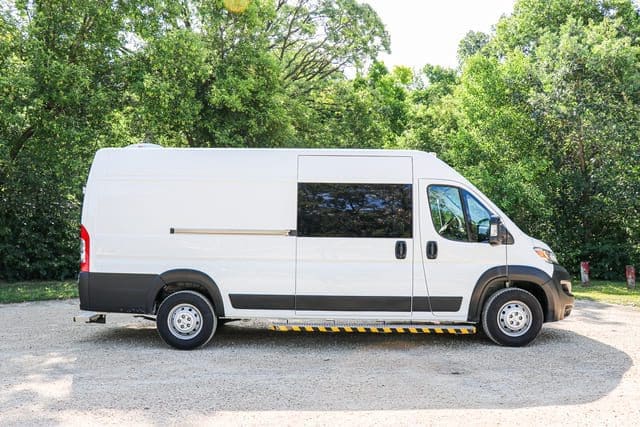Did you know Native American tribes in Arizona face some of the worst access to healthcare in the U.S.? Many people living on the Navajo Nation or in the Tohono O’odham Nation travel hours just to see a doctor, or skip care completely. That’s a big gap. It leads to more chronic illnesses, mental health struggles, and even early deaths. Watching your neighbors suffer because healthcare is too far away hurts.
This gap in access to healthcare leaves families stressed and communities mourning loved ones lost too soon. But imagine a different story. One where healthcare comes right to people’s streets and communities. Kids grow up healthy, and fewer families are hit by tragedy.
At AVAN Mobility, we’re here to help. For over 10 years, tribal health teams, nonprofits, and governments across the country have trusted us to build mobile clinics that break down barriers. We focus on dignity, safety, and local needs, because every community is different. And while we’re experts, we know we’re not the only choice. You deserve honest information.
In this article, you’ll learn:
- How these gaps affect Native American tribes in Arizona
- What problems come from it
- Ways your organization can close the gap with mobile clinics
5 ways poor healthcare access hurts Native American tribes in Arizona
When you look at access to healthcare in the U.S., Native American tribes in Arizona face some of the biggest gaps. It’s not just about long drives or busy clinics. It’s about lives cut short and families stuck in cycles of crisis. Here’s how it plays out every day in tribal communities across Arizona.
1. More chronic diseases go unchecked
When there’s poor access to healthcare in rural areas, people skip basic checkups. For Native American tribes in Arizona, this is a daily reality. Folks living on or near reservations often travel hours to see a doctor. Many just can’t make the trip.
What happens? Health problems that could be managed early turn serious fast.
- Silent damage: Diabetes or high blood pressure often have no obvious symptoms at first. By the time someone feels sick, organs might already be harmed.
- Expensive fixes: Waiting too long means care costs more. That strains tribal budgets and family wallets.
- Shorter lives: The effects of lack of access to healthcare show up in hard numbers. Native Americans have a life expectancy about 5 years shorter than other Americans.
When people get routine care, they catch problems early and live longer, healthier lives. That’s one big reason to care about improving access to healthcare right where people live.
2. Mental health struggles grow heavier
Another tough part of access to healthcare issues is how it affects mental health. For many Native American tribes in Arizona, finding a therapist or counselor close by is almost impossible. Clinics are often hours away, if they even exist. That means folks are left dealing with heavy stress, grief, or trauma on their own.
Here’s what happens:
- Isolation builds: Without local support, people shoulder their burdens alone. This deepens depression and anxiety.
- Crisis outcomes: Suicide rates among Native Americans are about twice the national average. Lack of nearby help is a big reason why.
- Family strain: Parents, grandparents, and kids all carry the weight, and it affects the entire community.
When you look at problems with access to healthcare in the United States, mental health is often left out of the conversation. But it’s a huge piece.
Helping your community heal emotionally is just as critical as treating physical illnesses. That’s why many programs today include mental health services right inside mobile clinics. It brings care home.
3. Financial stress and poverty climb higher
Access to healthcare in America can get pricey fast, especially when it’s far from home. For many Native American tribes in Arizona, that distance means big costs just to see a doctor.
Think about what families face when care is hours away:
- Travel costs stack up: Gas, hotels, and meals on the road eat into tight budgets. For many, it’s money they just don’t have.
- Lost income hurts: Time off work means smaller paychecks. Some skip visits because they can’t afford to miss a shift.
- Debt risks rise: Medical bills from emergency care add up, pushing some deeper into poverty. That’s a big reason why poverty and access to healthcare are so tangled.
This is one of those hidden causes of lack of access to healthcare—when families can’t afford the trip or the follow-ups, they skip care. That makes problems worse and costs even more later.
When care is local or mobile, it cuts these burdens. People don’t have to choose between a doctor visit and groceries. It’s a simple way to start improving access to healthcare and reducing poverty’s grip.
4. Delayed care turns small problems into big ones
One of the biggest access to healthcare issues for Native American tribes in Arizona is that folks often wait until problems get bad before seeing a doctor. Why? Because care is far away, costs too much, or means taking time off work. By the time they finally go, it’s no longer a simple fix.
Think about a small cut that doesn’t get treated. It can turn into a serious infection. A sore tooth becomes an abscess that needs surgery. A cough turns into pneumonia.
These are common examples of access to healthcare we see across tribal lands.
- Longer recovery times: People end up in the hospital for days instead of getting a quick prescription.
- More stress on families: Someone has to take time off work to help. That means less money coming in and more bills stacking up.
- Higher costs: Treating advanced problems is way more expensive. This hits tribal health budgets and family savings hard.
It’s a tough cycle. Delayed care leads to worse health, more time away from work or school, and deeper financial strain. That’s why tackling the causes of lack of access to healthcare matters so much.
5. Kids miss out on routine checkups and vaccines
When there’s poor access to healthcare in rural areas, kids pay a big price. For many Native American tribes in Arizona, seeing a pediatrician, dentist, or even getting basic vaccines means long trips. A lot of families can’t afford to take that time off work or spend money on travel. So kids skip regular care.
Here’s what happens:
- Small problems snowball: Cavities that could’ve been filled become painful infections. Minor vision issues don’t get caught early, hurting school performance.
- More missed school days: Kids battling preventable problems like untreated asthma or dental pain end up at home instead of learning.
- Long-term impacts: Missing vaccines or screenings can lead to lifelong challenges. That’s why access to healthcare in the U.S. for kids matters so much.
This ties back to bigger questions: how does cost affect access to healthcare, and what are the effects of a lack of access to healthcare on a child’s future? When care is local or mobile, kids stay on track with checkups and grow up stronger. It’s one way of improving access to healthcare that keeps families together and thriving.
How can your organization help fix the lack of access to healthcare?
When people lack access to healthcare, there’s a pretty logical next step. If they can’t get to the clinic, why not bring the clinic to them? Many Native American tribes in Arizona are doing exactly that. It’s a direct way to tackle the causes of lack of access to healthcare, cut costs, and protect lives.
So, how do you pull it off? By using a mobile clinic. It’s one of the smartest access to healthcare examples around. Instead of asking families to spend hours on the road for care, you deliver it right to their doorstep. It brings routine checkups, chronic disease care, dental visits, and mental health support straight to your streets.
This fills big gaps in care. It helps people stay on top of their health, so problems don’t get worse. That means fewer ER trips, less strain on tribal health budgets, and stronger, healthier communities. It’s also a hands-on way to level the field, fighting unequal access to healthcare and giving your people a fair shot at a healthy life.
How can a mobile clinic improve access to healthcare in Arizona?
A mobile clinic is a real clinic on wheels. It’s built for Arizona’s scorching summers, rugged roads, and long distances between communities. For Native American tribes in Arizona, this means bringing care straight to the people who need it most.
Here’s how these features help tackle the lack of access to healthcare across tribal lands:
Keeps patients safe in Arizona’s extreme heat
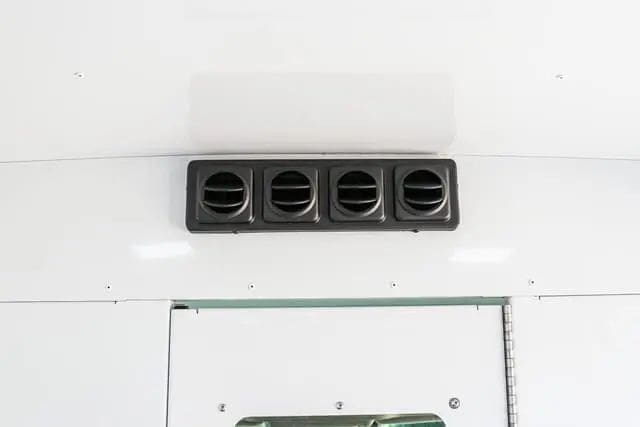
High-capacity heat and air conditioning keep your patients and team comfortable even in 110-degree weather. That matters for families on the Navajo Nation or Hopi lands, where summer days can be dangerous.
- No overheating: Patients wait inside in cool air instead of under the sun.
- Better care: Nurses and doctors stay focused, not sweating through exams.
- Year-round use: Heaters mean you can serve communities even in chilly winter mornings.
It’s one simple feature that makes your mobile clinic usable all year across Arizona, not just when the weather cooperates.
Reliable power keeps care steady
A mobile clinic’s strong power system means no worrying about equipment cutting out while you’re hours from the nearest town. This helps your staff run tests, store vaccines, and stay connected.
- Keep devices powered and ready: A strong and reliable power system is necessary when using medical equipment in your mobile clinic.
- Bright lighting: Exams stay thorough, even on cloudy days.
- Stay online: Charge tablets, laptops, or run telehealth calls on the spot.
It’s critical for tackling the lack of access to healthcare in rural areas, so your care is never interrupted by a dead battery.
Fully equipped for real medical visits
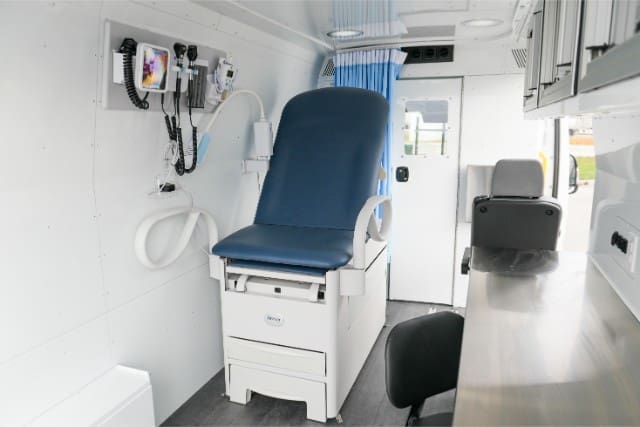
Your mobile clinic can be customized with options like a sink, fridge, privacy curtain, and awning, turning it into a true on-the-road clinic that fits how your team works.
- Stay clean: A sink makes hand washing and tool rinsing easy during field visits.
- Protect medication: A fridge keeps vaccines safe, even parked hours from the nearest pharmacy.
- Offer privacy: A privacy curtain lets patients share concerns without worry, critical for sensitive exams or mental health visits.
- Give shade: An awning helps families wait comfortably under Arizona’s intense sun.
These upgrades mean your mobile clinic is set up to serve people right where they live, from busy tribal centers in San Carlos to smaller homes outside Tuba City.
Designed for comfort and smart storage

A patient bed with under-bed storage plus floor-to-ceiling cabinetry makes exams easy and keeps supplies right at your team’s fingertips.
- Quick access: No digging through boxes for bandages or blood tubes.
- Safer rides: Cabinets keep items from bouncing around on rocky Arizona roads.
- Comfortable exams: A proper exam bed means thorough checks, not awkward workarounds.
It’s how you keep care efficient, even traveling between San Carlos and Tohono O’odham.
Built to tackle Arizona’s rugged roads

Arizona roads aren’t always paved. The Trail Edition upgrades give your clinic heavy-duty suspension, tires, and ground clearance.
- Reach remote homes: Drive into tiny settlements without fear.
- Reduce trip cancellations: Fewer days you’re forced to turn back.
- Protect your investment: Less wear and tear keeps the clinic working longer.
This means patients deep in the White Mountains or near the Utah border still get visits.
Office space for your team
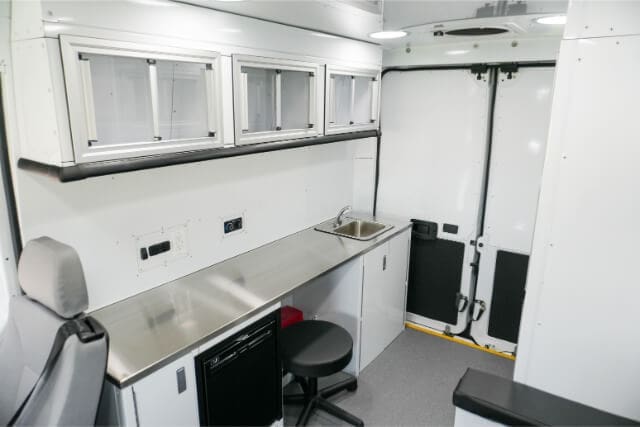
A mobile clinic’s built-in medical office with a desk, secured rolling chair, outlets, and 12V plugs keeps your team organized.
- Chart visits on-site: No stacks of papers to handle later.
- Host telehealth: Patients connect to specialists right from the van.
- Recharge gear: Keep everything powered, from phones to medical scanners.
It’s one more way mobile clinics bridge access to healthcare gaps, making your staff’s work smoother and more professional.
Ready to fix the lack of access to healthcare in Arizona?
You probably came here because you’ve seen firsthand how hard it is for people in Arizona to get care. Maybe families skip appointments because the hospital is hours away, or elders miss routine checkups simply because the trip costs too much. It’s a heavy burden for many Native American tribes in Arizona.
Here’s what you learned today:
- Why access to healthcare matters: Poor access leads to higher rates of chronic disease, mental health struggles, and financial stress in tribal communities.
- How mobile clinics help: These clinics bring care right to your door, built for Arizona’s tough roads, harsh heat, and rural distances.
At AVAN Mobility, we’ve 100+ mobile clinics across the U.S., each one tailored to the community it serves. We don’t take a cookie-cutter approach. Your mobile clinic is designed around your people, your land, and your program goals. That’s why tribal health teams, nonprofits, and governments trust us to be their partner long after the van is delivered. We believe better health should never be out of reach, and we’d be honored to help your program get there.
Got questions? Click the button below to chat with a mobility expert who’s helped teams just like yours. If you’re not ready to talk yet, we’ve got more helpful resources for you.
Check these out:
- Top 10 tips on fundraising for a Mobile Clinic Van: Get creative ways to fund your project, so money doesn’t hold back your mission.
- How much does a mobile clinic cost in Arizona? Learn what to budget for, from the van itself to the extras that make it truly yours.
- Mobile clinic maintenance in Arizona: Learn how to keep your mobile clinic in tip-top shape.


